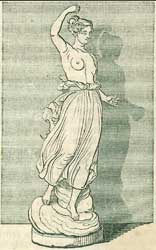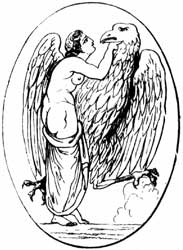Hebe
"Freshness of youth." The personification of youth, is described as a daughter of Zeus and Hera,1 and is, according to the Iliad,2 the minister of the gods, who fills their cups with nectar; she assists Hera in putting the horses to her chariot;3 and she bathes and dresses her brother Ares.4

According to the Odyssey,5 she was married to Heracles after his apotheosis. Later traditions, however, describe her as having become by Heracles the mother of two sons, Alexiares and Anicetus,6 and as a divinity who had it in her power to make persons of an advanced age young again.7
Hebe was worshiped at Athens, where she had an altar in the Cynosarges, near one of Heracles.8 Under the name of the female Ganymede (Ganymeda) or Dia, she was worshiped in a sacred grove at Sicyon and Phlius.9

At Rome the goddess was worshiped under the corresponding name of Juventas.
❧
Iconography
Hebe was regarded as a blossoming young woman. On many Greek vases she is portrayed -- wearing a sleeveless chiton -- as the cup-bearer of the gods or as the bride of Heracles (such as on the Apulian amphora). A famous statue of Hebe, made of gold and ivory and created by Naucydes (fifth century BCE), is unfortunately lost. It is depicted on later coins from Argos.
References
Notes
Sources
- Aken, Dr. A.R.A. van. (1961). Elseviers Mythologische Encyclopedie. Amsterdam: Elsevier.
- Smith, William. (1870). Dictionary of Greek and Roman Biography and Mythology. London: Taylor, Walton, and Maberly.
This article incorporates text from Dictionary of Greek and Roman Biography and Mythology (1870) by William Smith, which is in the public domain.